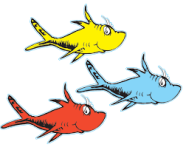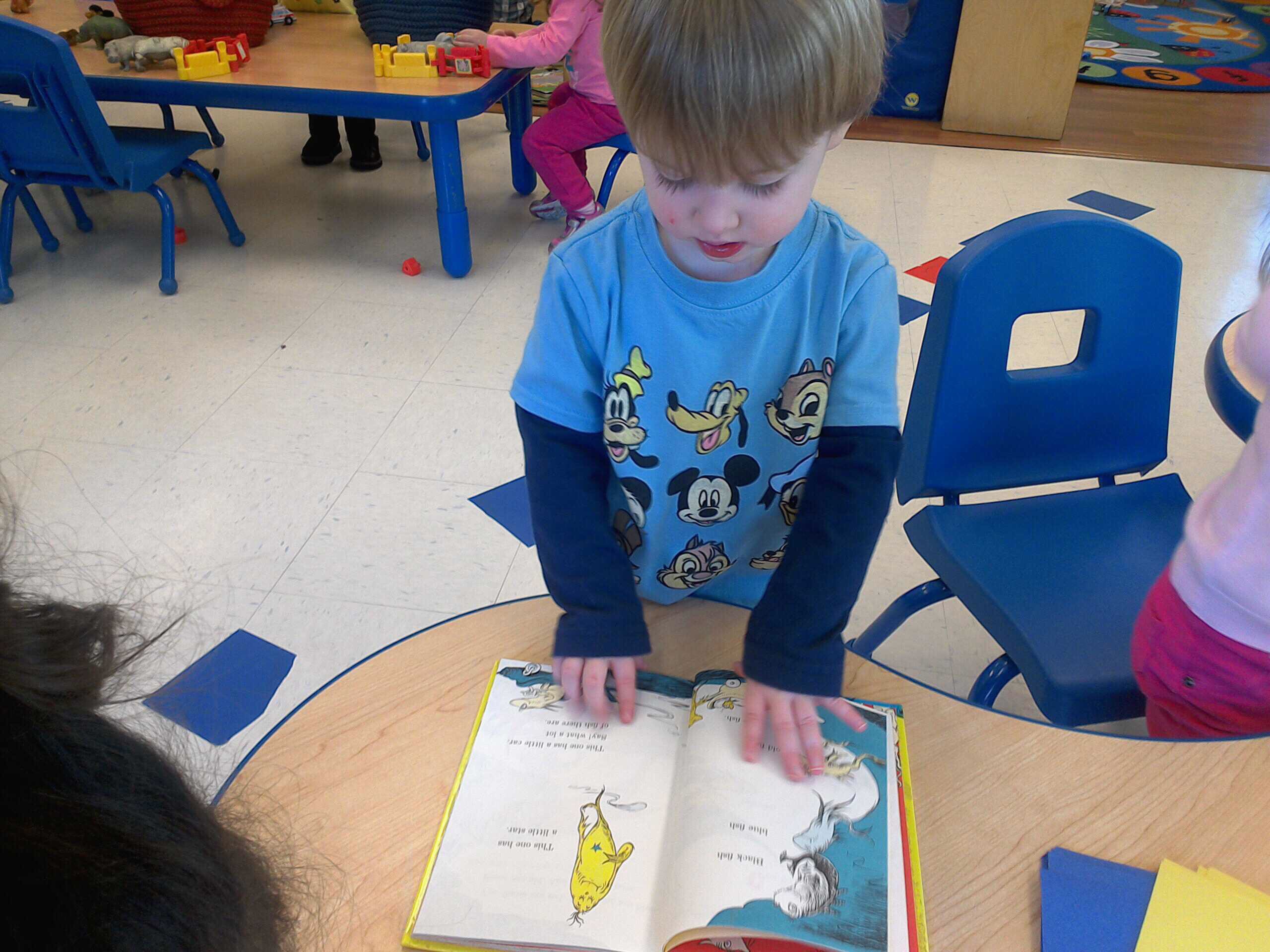Matt Harvey
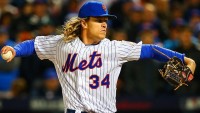
Going into the 2016 season, there is one fear each and every Mets fan has. We dare not speak its name, but that doesn’t change the fact that it’s still present. That fear is that a pitcher will get seriously injured.
Looking at this year’s list of pitchers who could befall the dreaded “Verducci Effect,” Noah Syndergaard headlines that list. If Syndergaard was to suffer a season ending injury requiring Tommy John surgery? it would greatly hinder the Mets chances of winning not only the World Series, but also making it to the postseason. It’s something that not just Mets fans fear, but as Anthony DiComo of MLB.com reports, Syndergaard fears it also:
I’ve thought about it quite a bit. But I trust myself to put my body in the right situations to be able to perform at a healthy level.
The fear is justified. Syndergaard threw 65.2 innings more last year. He throws over 95 MPH more than anyone in the game. He’s working to add the fabled Warthen Slider to his already dominant repertoire. Name a risk factor for UCL years requiring Tommy John surgery. Syndergaard meets most if not all of them.
One risk factor not readily discussed is the team he plays for. Look at the projected Mets rotation when healthy: Matt Harvey, Jacob deGrom, Noah Syndergaard, Steven Matz, and Zack Wheeler. Put aside Syndergaard for a moment. What do the other four have in common? They are all hard throwing pitchers under the age of 30 who have already had Tommy John surgery.
Go outside this group. Since Warthen took over as the Mets pitching coach, the following homegrown Mets have sustained arm injuries: Jon Niese (shoulder), Dillon Gee (shoulder), Jeremy Hefner (two Tommy John surgeries), Rafael Montero (shoulder), Bobby Parnell (Tommy John), Josh Edgin (Tommy John), Jack Leathersich (Tommy John). There are more, but you get the point.
Now, is this an organizational problem since Warthen took over, or is it just bad luck? Could this all have been avoided? Back in the 60’s and 70’s the Mets developed pitchers like Tom Seaver, Jerry Koosman, Nolan Ryan, and Jon Matlack. These pitchers threw more innings than the pitchers today, and yet, Matlack was the only one of this group that suffered an arm injury.
In the 80’s, the Mets had Dwight Gooden, Ron Darling, Sid Fernandez, Rick Aguilera, Randy Myers and David Cone. Of this group, only Doc and Cone had arm issues. It should be noted that Doc had many other issues as well, and Cone’s problem was an aneurysm later in his career.
In the 90’s, Generation K was a bust, and the Mets haven’t developed the caliber of starting pitchers like they have in the past until now. However, this generation seems to befall injuries far more often than their predecessors. Is it organizational? Is it bad luck? Is it preparation? For his part, Harvey wonders what if:
I think now, there are things I could have done better in high school or in college to maybe prevent it. But I don’t know. I’m not saying [Syndergaard] works that much harder than everybody else, because we all work hard. I think as time progresses, guys pay more attention to stretching the shoulder, strengthening the shoulder. If I could go back — I don’t know if this would’ve prevented me from having [surgery], but if I could go back and really do 20 extra minutes of stretching and arm care, you never know what could happen.
That’s the thing. We really don’t know why one guy suffers elbow and shoulder injuries while others don’t. Is it preparation? Is it good genes? Is it just good luck? Much time, energy, and money has been spent on this issue, and yet pitchers still get injured. Pitchers get injured despite teams doing everything in their power to try to prevent it.
It will help Syndergaard being in a clubhouse with players who have had Tommy John surgery. They each will have advice for him on why they suffered the injury and what they could’ve done differently. More importantly, Syndergaard appears to be a hard worker who takes the health of his arm very seriously. There is no doubt he is doing everything he can do to avoid the dreaded Tommy John surgery.
Based on what we’ve seen, if anyone can avoid it, it’s him.
Editor’s Note: this article was first published on metsmerizedonline.com

Excuse me for a moment. I’m going to rip a page right out of the script from A Time to Kill:
I want to tell you a story. I’m going to ask you all to close your eyes while I tell you the story. I want you to listen to me. I want you to listen to yourselves. Go ahead. Close your eyes, please. This is a story about a Mets pitcher. He comes to Spring Training after a big year, and he is upset with his contract. He wants to get paid what he thinks he deserves, but he is forced to accept what the Mets give him. In his first Spring start, his velocity is down. He’s unhappy with his contract, and he still has more work to do in Spring Training to get ready for the season. Can you see him. I want you to picture that Mets pitcher. Now, I want you to imagine he’s Jacob deGrom.
Look, everyone assumes it’s Matt Harvey who is going to be difficult to agree to a contract extension. It’s his off-the-field social life that gets highlighted, and for some, it creates the presumption that he does not do all he can do to be prepared for the 2016 season.
However, this Spring Training, it’s been deGrom who has complained about his salary, which is something Harvey didn’t do. He was the Mets pitcher that went out his first start and didn’t have people espousing that he’s in mid-season form.
Note, this is definitively not a criticism of deGrom. He has done nothing to deserve criticism. I take no umbrage with him wanting to get paid what he thinks he’s worth. I applaud him wanting to sign an extension to stay with the Mets. I will not read anything into one Spring Training start. So far in his young career, deGrom has been ready to pitch when called upon.
It should also be noted Harvey has also stated he would be open to signing an extension to stay with the Mets. Of course when Harvey says it, people are dismissive of the concept. The real difference between Harvey and deGrom is perception.
With the innings limit drama last year, deGrom is seen as a team first guy, and Harvey is seen as a me first guy. I’m not sure that characterization is entirely fair. Harvey pitched all postseason, and he never asked out of a game. Rather, he wanted the ball.
The Mets are blessed to have three aces. They all want to win, and they are doing what is necessary to win a World Series. Let’s just enjoy them instead of creating narratives that they don’t want to be here, or that they only care about themselves.
It’s not fair, and it’s not right. It’s time for Mets fans to press the reset button on their relationship with Harvey.

There are no dumb questions. In some respects, the question itself is more enlightening than the answer itself.
That is the case with Matt Harvey being asked if “he can finally just be a ‘regular guy’ again.” That’s a loaded question. Does this mean him being a regular guy like you or me (or you)? Does this mean him being just one of the guys in the clubhouse? Does this mean Harvey returning to his old self after his first complete year back from Tommy John? Seriously, it’s a loaded question.
The fact of the matter is Harvey will never be just a “regular guy.” He’s been a lightning rod. He was the first pitcher called-up. He gave Mets fans hope. He started an All Star Game, had an incredible 2013, and pitched that incredible World Series game. His innings and starts have been an issue. He’s got a boisterous agent and a high profile off the field. So no, Harvey never was and never will be a regular guy.
That’s a good thing.
At his core, Harvey is an ace. Aces are cut from a different material than the rest of us. They go to the mound with a certain swagger that some would call arrogance. His lone job is to get you out. It’s not a problem for him because he’s better than you are. He believes each pitch has a purpose. Each pitch is unhittable. His mindset is important. His stuff puts him on a different level than everyone else.
So no, Harvey is not a regular guy. I wouldn’t have it any other way.

So far, the big Matt Harvey story of the preseason is the return of his vaunted slider. According to Harvey, he did not have it for most of last year.
For what it’s worth, Spring Training is always full of stories pumping up players. Every player appears to be in the best condition of their life. Players are healthier than they have ever been in their career. They’re either ready to build upon a strong season or put a tough season behind them. Does the supposed return of Harvey’s slider fit into that catergory?
In 2013, Harvey’s breakout season, he was 9-5 with a 2.27 ERA, 0.931 WHIP, 157 ERA+, 2.01 FIP, and a 9.6 K/9. He threw his slider 18.5% (504 total) of the time. Rather than try to explain how his slider moved, here’s a two graphs from Brooks Baseball showing the vertical and horizontal movement of Harvey’s 2013 slider:

 When Harvey threw his slider, it was swung at 49.01% of the time. When batters swung at the pitch, it was fouled off 15.8% of the time. It generated a swing and miss 17.66% of the time, and it was put into play 16.88% of the time. When contact was made, it typically generated a groundball. He only allowed two homeruns off of the pitch. In sum, it was a terrific pitch for him.
When Harvey threw his slider, it was swung at 49.01% of the time. When batters swung at the pitch, it was fouled off 15.8% of the time. It generated a swing and miss 17.66% of the time, and it was put into play 16.88% of the time. When contact was made, it typically generated a groundball. He only allowed two homeruns off of the pitch. In sum, it was a terrific pitch for him.
Now, if we use Harvey’s word that his slider didn’t return until the last quarter of the season, it means he didn’t have his slider until August. Again, using Brooks Baseball, here are graphs showing the vertical and horizontal movement of Harvey’s slider:


Taking a cursory look, Harvey’s slider had less horizontal and vertical movement. Unsurprisingly, the pitch was not as effective for Harvey.
From April to July, Harvey threw this slider less frequently than his old slider. His slider usage rate dropped from 18.5% to 15.12%. During these months, Harvey relied much more heavily on his fastball. Part of the reason for that might’ve been his lack of confidence with his slider.
When Harvey did throw his slider, it was swung at 43.92% of the time. When batters did swing at the pitch, they fouled it off 9.12% of the time, swung and missed 17.57% of the time, and put it in play 17.57% of the time. While the new slider did generate more groundballs, it did also generated less swings and misses.
More importantly, it needs to be reiterated that Harvey did not have the confidence in this pitch that he did in 2013. To an extent, it changed what he was as a pitcher, and the results showed. From April until July, Harvey went 9-7 with a 2.91 ERA, 1.06 WHIP, and an 8.5 K/9.
Harvey said he found his slider sometime in August. Here’s how his slider moved from August through the postseason:
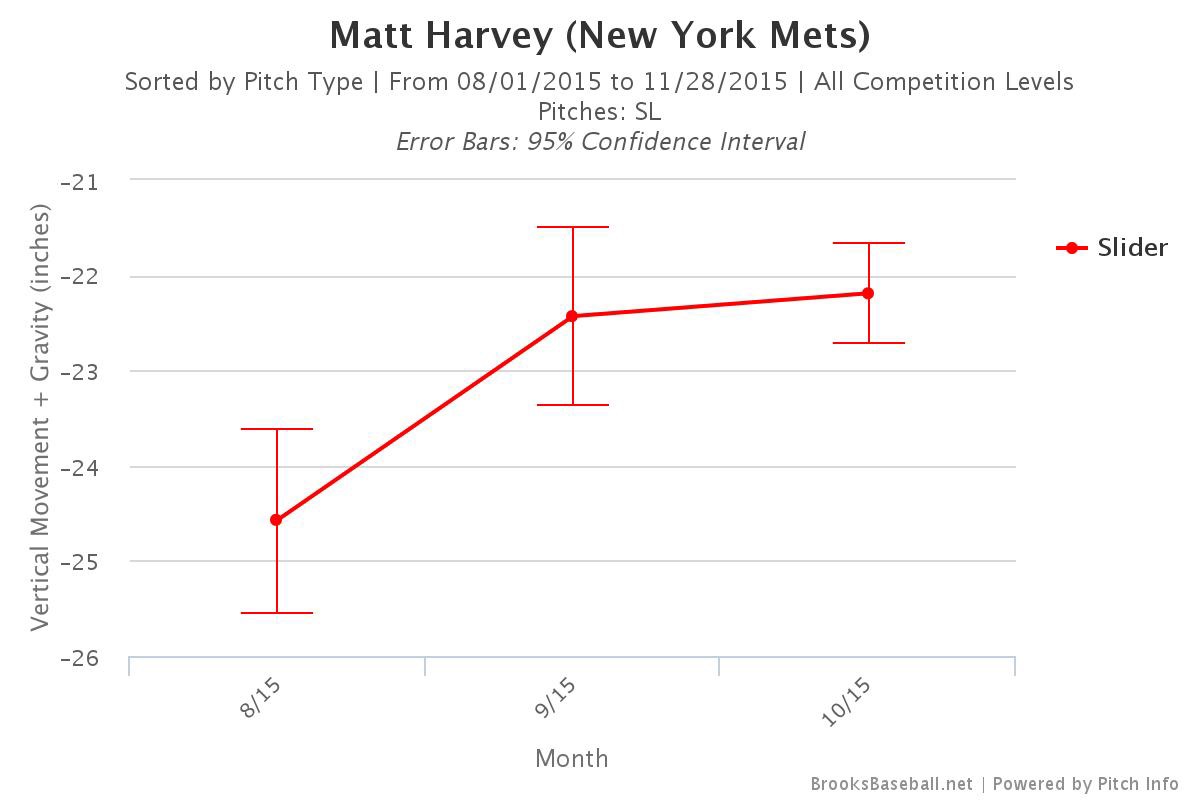
 Looking at the charts, Harvey’s slider appeared to get its movement back, especially in August. What is surprising is that Harvey used his slider even less frequently than he had done in the first five months of the season. His slider usage rate dropped to 13.10%.
Looking at the charts, Harvey’s slider appeared to get its movement back, especially in August. What is surprising is that Harvey used his slider even less frequently than he had done in the first five months of the season. His slider usage rate dropped to 13.10%.
When he did throw it, it was more effective. Batters swung at the slider 53.03% of the time. When batters did swing at the pitch, it was fouled off 15.91% of the time, swung and missed 18.94% of the time, and put in play 18.94% of the time. Harvey’s rediscovered slider was able to generate a similar percentage of groundballs as he had between April – July.
To close out the regular season, Harvey was 4-1 with a 2.24 ERA, 0.927 WHIP, and a 10.1 K/9. While we should always be careful of drawing conclusions from short sample sizes, it appears that the 2013 Cy Young caliber version of Harvey is back.
Judging from Harvey’s first Spring Training start, he still has his slider. With that, Harvey should have increased confidence, and more importantly better stuff out there in the mound. Now that the slider will be back for a full season, Harvey is back in the Cy Young discussion (if he ever left), and he is primed to dominate the National League.
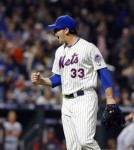
In 2015, Matt Harvey became the pitcher who has thrown more innings than any other pitcher post-Tommy John surgery. In fact, he became only the fifth pitcher to throw more than 200 innings in the first year post-Tommy John surgery. The other four are:
- Tommy John 207.0 IP
- Jake Westbrook 202.2 IP
- Adam Wainwright 213.2 IP
- John Lackey 215.1 IP
Last year, Harvey had a very good year in his first year back. In determining how next season will go, we should look to these other four pitchers as they are the only other pitchers who have thrown as many innings as Harvey has after Tommy John surgery.
Tommy John
As we all know, Tommy John was the first pitcher to return from Tommy John surgery. Obviously, he had a successful return as physicians have continued to perform the surgery to resuscitate pitchers’ careers.
In 1974, John’s last season before surgery, he went 13-3 with a 2.59 ERA and a 1.144 WHIP. He had a 2.74 FIP and a 132 ERA+. He only lasted 22 starts throwing 159.0 innings before shutting it down, having the sugery, and missing the 1975 season.
In 1976, John returned to the Dodgers. He went 10-10 with a 3.09 ERA and a 1.295 WHIP. He had a 3.08 FIP and a 109 ERA+. He made 31 starts and threw 207.0 innings. He returned, and he was able to pitch. However, he did not pitch nearly as well as he had prior to the surgery.
In 1977, John returned to form. He was 20-7 with a 1.248 WHIP. He had a 3.05 FIP and a 138 ERA+. He made 31 starts throwing 220.1 innings. He finished second in the Cy Young voting. He was better than he was pre-surgery.
With Tommy John, we saw a pitcher get better the second year after his surgery. Also, looking over the rest of his career, John was able to pitch until he was 46 years old. Accordingly, we can reasonably conclude that the 200 innings post-surgery did not negatively impact his career. We can also reasonably conclude that John was better and stronger than those 200+ innings.
Jake Westbrook
In 2008, Westbrook was only able to make five starts before needing Tommy John surgery. In 2007, his last presumably healthy season, he pitched 152.0 innings going 6-9 in 25 starts with a 3.12 ERA, 1.408 WHIP, 4.33 FIP, and a 105 ERA+.
From 2004-2006, Westbrook had pitched over 200 innings in each season with an ERA+ ranging from 93-127. In the 2004-2007 timeframe, Westbrook had a 91.69 MPH fastball, 81.69 MPH change, 80.55 MPH curve, and an 88.40 MPH cutter.
When Westbrook returned from surgery in 2010, he threw 202.2 innings over 33 starts between the Indians and the Cardinals. He had a 4.22 ERA, 1.337 WHIP, 4.22 WHIP, and a 93 ERA+. Upon his return, he threw a 91.07 MPH fastball, 79.63 MPH change, 83.56 MPH slider, 79.78 MPH curve, and an 86.07 MPH cutter.
The following season, Westbrook made 33 starts pitching 183.1 innings. He went 12-9 with a 4.66 ERA, 1.533 WHIP, 4.25 FIP, and an 80 ERA+. He had a 90.76 MPH fastball, 80.22 MPH change, 79.52 MPH curve, 86.44 MPH cutter.
Westbrook’s career would only last two more seasons. He never again reached 200 innings in a season. He didn’t have the rebound Tommy John seemed to have, but then again, Westbrook was never the pitcher John was.
Adam Wainwright
In 2010, Wainwright went 20-11 with a 2.42 ERA, and a 1.051 WHIP in 230.1 innings. He had an ERA+ of 160 and an FIP of 2.86. He was an All Star, finished second in the Cy Young voting, and was a top 20 MVP candidate. He would also need Tommy John surgery after this season.
Before the surgery, Wainwright’s repertoire included a 91.73 MPH sinker, 83.56 MPH change, 74.69 MPH curve, and a 86.44 MPH cutter. With this repertoire, he had consecutive seasons of 200+ innings pitched, 19+ wins, and a sub 2.65 ERA.
After rehabbing during the 2011 season, Wainwright returned to throw 213.2 innings between the regular season and playoffs. Wainwright would go 14-13 with a 3.94 ERA and a 1.248 WHIP in 198.2 innings in the regular season. He had a 96 ERA+ and a 3.10 FIP. He returned with a 90.70 MPH sinker, 84.25 MPH change, 74.50 MPH curve, and an 86.07 MPH cutter.
The following year, Wainwright seemed to return to his pre-Tommy John form. He was 19-9 with a 2.94 ERA and a 1.068 WHIP. He led the league with 241.2 innings pitched. His ERA+ was 127, and his FIP was 2.55. He threw a 92.08 MPH four seamer, a 91.06 MPH sinker, 84.56 MPH change, 76.12 MPH curve, and an 88.60 MPH cutter. He was an All Star, a Gold Glover, a top 20 MVP candidate, and he finished second in the Cy Young voting.
Wainwright followed this up with a strong 2014. He would miss most of 2015 with a torn Achillies. Like Tommy John, he was a much better pitcher the second year after Tommy John surgery.
John Lackey
There was a time it was thought that Lackey forgot how to pitch when he signed a contract with the Red Sox.
In 2009, Lackey’s last year with the Angels, he was 11-8 in 176.1 innings over 27 starts. He had a 3.83 ERA, 1.270 WHIP, 115 ERA+, and a 3.73 FIP. He threw a 92.11 MPH four seamer, 91.83 MPH sinker, 85.68 MPH change, 82.68 MPH slider, and a 79.37 MPH curve.
Interestingly in the two years prior to his surgery, Lackey threw a 92.06 MPH four seamer, 91.42 MPH sinker, 84.83 MPH change, 85.53 MPH slider, and an 80.02 MPH curve. He went 26-23 with a 5.26 ERA, 1.504 WHIP, 82 ERA+, and a 4.21 FIP. While he made 33 starts pitching 216.0 innings in 2010, he was only able to make 28 starts while pitching 160.0 innings in 2011.
In 2013, he returned to throw 215.1 innings between the regular season and postseason. In the regular season, he was 10-13 in 29 starts throwing 189.1 innings. He had a 3.52 ERA, 1.157 WHIP, 117 ERA+, and a 3.86 FIP. He threw a 92.64 MPH four seamer, 92.04 MPH sinker, 84.19 MPH change, 86.28 MPH slider, and an 80.33 MPH curve.
Lackey followed this up with a strong 2014. In 2014, he pitched 198.0 innings going 14-10 in 31 starts between the Red Sox and Cardinals. He had a 1.278 WHIP, 102 ERA+, and a 3.78 FIP. He pitched an additional 13.1 innings in the postseason giving him 213.1 innings total. He threw a 92.7 MPH four seamer, 92.24 MPH sinker, 84.43 MPH change, 84.49 MPH slider, and a 79.10 MPH curve.
Lackey had an even better 2015. Like John and Wainwright, Lackey got better the second year away from Tommy John. As such, in three of the four test cases, pitchers who threw 200 innings in the first year post Tommy John improved the second year after surgery.
Matt Harvey
Matt Harvey has thrown more innings than any other pitcher who has had Tommy John surgery. He’s also the youngest of the group, and he throws the hardest.
In 2013, Harvey was the All Star Game starter and an early Cy Young candidate. In the abbreviated season, he finished fourth in the Cy Young voting. Before he was shut down, he went 9-5 in 26 starts pitching 178.1 innings. He had a 2.27 ERA, 0.931 WHIP, 157 ERA+, and a 2.01 FIP. His FIP lead the league. Before he was shut down, he threw a 96.63 MPH four seamer, an 87.79 MPH change, a 90.50 MPH slider, and an 84.25 MPH curveball.
When Harvey returned, he threw a 96.46 MPH four seamer, 88.78 MPH change, 90.24 MPH slider, and an 84.35 MPH curveball. So, Harvey did return with similar velocity than he had before the surgery. That may be, in part, due to the fact that he had about 18 months of rehab as opposed to the year of rehab he predecessors had.
In the regular season, Harvey pitched 189.1 innings in 29 starts. He went 13-8 with a 2.71 ERA, 1.000 WHIP, 136 ERA+, and a 3.05 FIP. Looking over these numbers, Harvey’s stuff might’ve returned, but he still had a period of adjustment. While he had respectable numbers, he did not produce results similar to what he did in 2013. By judging by the previous pitchers, we can reasonably expect Harvey to return to his 2013 levels.
So overall, now that he has a year under his belt, and he has his full arsenal at his disposal, Matt Harvey is primed to have a Cy Young caliber 2016.
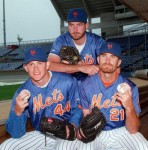
The year was 1996. The Mets were supposed to open the season with a trio of pitchers dubbed Generation K. Jason Isringhausen, Paul Wilson, and Bill Pulsipher were all supposed to usher in the next era of great Mets pitching. They were supposed to win multiple Cy Youngs and World Series titles.
It never happened.
Bill Pulsipher
Pulsipher was the first to arrive on the scene. In his first year in AA, a 20 year old Pulsipher pitched 201.0 innings. The prior year he only pitched 139.2 innings. The following year, 1995, Pulsipher would pitch in AAA and get called up to the majors. He threw 218.1 innings. Pulsipher wouldn’t pitch in 1996 as he had a torn ligament in his pitching elbow.
In Pulsipher’s rookie year, he made 17 starts. He never reached that plateau again. His last major league appearance came in 2005 when he was 31 years old. When Pulsipher made those five appearances, it was the first time he pitched in the big leagues since 2001. Pulsipher finished his career going 13-19 with a 5.15 ERA in 46 starts and 60 relief appearances.
Paul Wilson
Unlike Pulsipher, Wilson burst on the scene in 1996. He was the first overall pick in the 1994 draft after dominating at Florida State. In 1995, Wilson pitched his first season of professional ball, and he pitched well in his 186.2 innings. So well in fact, that the Mets called him up to the majors. He went 5-12 with a 5.38 ERA in 26 starts. His season would end as he needed arthroscopic surgery to repair a torn labrum in his pitching shoulder.
Wilson would never pitch for the Mets again. He would be part of a trade on 2000 for a fourth outfielder in Bubba Trammel and a bullpen arm in Rick White. He finished his career going 40-58 with a 4.86 ERA in 153 starts and 17 relief appearances.
Jason Isringhausen
Without a doubt, Isringhausen had the best career of the Generation K pitchers, and he had to go to the bullpen to do it.
Isringhausen burst on the scene in 1995. In 14 starts with the Mets, he went 9-2 with a 2.81 ERA. Even though he only pitched in half a season, he was so impressive that he finished fourth in the Rookie of the Year voting. While he may not have been the most heralded pitcher of Generation K, he had the most success out of all of them when he was first called up. However, that success would not last as like the other two pitchers, Isringhausen’s arm was a ticking timebomb.
In 1994, the year before Isringhausen pitched in the majors, he threw 193.1 innings. The year before? He threw only 90.1 innings. In his career, Isringhausen would need shoulder surgery and three Tommy John surgeries. This doesn’t even include surgery for a broken wrist because he lost a fight with a water cooler.
Isringhausen would eventually make two All Star teams due to his work as a closer. He would record 300 saves. The last seven were with the Mets in 2011 when he came back on a minor league deal. At that point, he served as a mentor to a young bullpen. It was a nice bookend towards the end of his career. The former young hothead with arm troubles became a veteran leader.
Generation K
These three heralded young pitchers were ruined by the Mets organization. They were needlessly pushed beyond their limits in the minors and majors. As a result, they had a series of shoulder and elbow injuries. The heralded trio would never appear in the same rotation.
Epilogue
It’s been four years since Isringhausen has retired, and now people want to interview him when we talk about how prospects should be handled. Here’s what he revealed about how those Mets handled prospects:
Jason Isringhausen: In the minors if we didn't pitch 9 innings, we got a talking to. We didn't watch pitch counts as much as we do today
— MLB Network Radio on SiriusXM (@MLBNetworkRadio) March 3, 2016
Twenty years later, the Mets have a new trio, who for some reason don’t have a great nickname like Generation K. While Jacob deGrom and Matt Harvey have had Tommy John surgery, the Mets handle their young aces much better now. They took better care of their pitchers during the rehabilitation process. Last year, we saw deGrom and Harvey team up with Noah Syndergaard to pitch the Mets into the World Series.
This was supposed to happen 20 years ago. It’s happening now. So next time, the Mets are too patient with a player, or a player or his agent voice concerns over a pitcher’s workload, remember Mets fans were robbed of seeing three aces in one staff due to over usage of the young pitchers.
I’m sure innings limits, six man rotations, and skipped starts will be a story line at some point in 2016. When it does, embrace it because the Mets not using that forward thinking might’ve cost at least one World Series title. Young pitchers are fragile, and they need to he handled as such. If you don’t, the workload could lead to injuries and/or ruined careers. Next thing you know, the window to win a World Series is slammed shut.
I’m not willing to see another chance go by the wayside due to some meaningless starts again.

When we talk about the Mets locking up their young pitching, the general consensus is Jacob deGrom is the person most likely to sign an extension before he hits free agency.
For his part, deGrom has said he is open to an extension. He is the oldest pitcher of the group. His agent isn’t Scott Boras. He’s not a local kid who grew up rooting for the Yankees. deGrom seems more affable than a Matt Harvey, so most assume he will re-sign with the Mets at a somewhat discounted rate. Well, today that notion flew out the window:
Statement from Brodie Van Wagenen, Jacob deGrom's agent. pic.twitter.com/6ARbCyaUeb
— Marc Carig (@MarcCarig) March 4, 2016
Let’s not overstate the meaning of this. deGrom thought he was worth more than the $607,500 he is going to be paid next year. He wasn’t going to agree to it, but under the Collective Bargaining Agreement, he had no recourse but to not sign the deal. As is their right, the Mets accepted deGrom’s decision and then told him he was going to be paid that amount whether he liked it or not.
This is not a strain in the relationship between deGrom and the Mets. The only thing that can be gleaned from this is deGrom is not willing to sign an under-value market contract. So what is his market?
The Mets will not have to pay deGrom next year until he hits arbitration as a Super Two player. Judging from Harvey’s first year of arbitration, he will be slated to receive around $4.325 million. If deGrom fights for much more than that, we will all know the type of fight the Mets will have when deGrom gets closer to free agency.
As it stands, deGrom will become a free agent two years after Harvey. When Harvey does become a free agent, it will be around the time the Mets could begin talks with deGrom on an extension to buy out his remaining years of arbitration and a couple of years of his free agency.
When deGrom does hit free agency, he will be 32 years old. If he signs two years prior to free agency, he will be 30 years old. We saw this offseason that 30 year old pitchers can receive massive free agent deals. David Price just signed a 7 year $217 million contract with an opt out after three years. For his part, Zack Greinke, 32, signed a six year $206 million contract. These two pitchers are being paid between $30 – $35 million per year.
Now, deGrom doesn’t have Price’s or Greinke’s credentials . . . yet. deGrom won the Rookie of the Year award in 2014. He was the star at the All Star Game in 2015. He finished Top 10 in Cy Young voting. He had a historic start to the postseason out-dueling Clayton Kershaw in Game One. He then beat the aforementioned Greinke in Game Five. If deGrom continues on this path, he will certainly be worth something in the ballpark of $30 million per year. deGrom’s actions today certainly points to him not wanting anything less than what he thinks he is worth.
Now, on an extension, the Mets can manipulate how much deGrom earns when and try to give him deferred money. However, it is fair to assume deGrom could command close to an average annual value of $30 million per year. As it stands, it appears the Mets will have between $35.5 – $49.5 million to spend on pitching and a bench.
Therefore, as it stands, if deGrom is going to insist on an extension at what he perceives as his value, as is his right, the Mets will have to expand the payroll beyond $140 million to lock up their pitching.
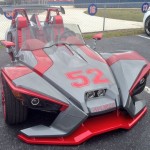
Overall, it’s hard to imagine a scenario where Yoenis Cespedes‘ 2016 season isn’t a disappointment. He’s expected to break Barry Bonds (or Roger Maris‘) single season homerun record, Hack Wilson‘s single season RBI record, and find a cure for cancer. Yes, this is hyperbole, but it’s really not that far from what’s being expected of him.
After his incredible run last year, Cespedes has set the bar sky high. When he came to the Mets, he played the best baseball of his life. It was some of the best baseball anyone has ever seen. More than anything, this has been the reason why he’s had all the attention surrounding him. If Tim Teufel had these cars, it would be an amusing antidote, but it wouldn’t be the focus of each and every day this Spring.
Look, the Cespedes’ car thing has been terrific. It’s added some fun to Spring Training. We’re talking about this instead of Terry Collins leaving in Matt Harvey, David Wright‘s back, Jacob deGrom tweaking his groin, Alejandro De Aza‘s possible discontent, or Roger Bernadina having visa issues. No, the Mets are having a fun camp in large part due to Cespedes.
That’s is unless you’re John Harper of the Daily News:
Just as Mets fans were quick to turn on Harvey during the innings-limit controversy last season, citing his look-at-me tendencies, they’ll tire quickly of hearing about Cespedes’ lifestyle if he doesn’t put up big numbers.
Same goes for the clubhouse. Teammates will gladly accept Stsr behavior as long as it comes with star performance. And certainly Cespedes has earned plenty of slack in this area, having astonished his fellow Mets with his offensive exploits last summer after coming over from the Tigers on July 31.
Why are we preemptively chastising Cespedes? Keep in mind, this is the same writer that despite knowing all of the “issues” Cespedes presents, he implored the Mets to re-sign him. Now that he’s here, what’s the point of tearing him down?
Cespedes was everything the Mets thought he would be and more last year. So far, he has been everything we thought he would be this Spring Training. It makes sense that the guy with the neon yellow arm sleeve and the 52 medallion would have an epic car collection. It makes more sense that Cespedes was going to be the focal point of this team no matter what he did. Why not have some fun along the way?
Look, his season is bound to be a disappointment. His 162 game averages are “only” 30 homeruns and 103 RBI. That’s not going to be enough for some people. That’s a shame because fans wanted Cespedes here, and he wanted to be here. No matter what Cespedes does this season that should be celebrated. Instead, the Daily News is already finding ways to tear him down.
These preemptive attacks should be driven off a cliff.
Editor’s Note: this column first appeared on metsmerizedonline.com
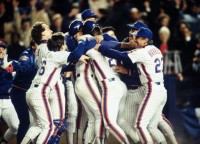
I remember back in 2000, the stories were that Bobby Valentine needed to make the World Series in order to keep his job. The amazing thing is he actually did it.
Just think about everything that had to happen that year for the Mets to make the World Series. First, the Mets had an overhaul of its outfield during the season. On Opening Day, the Mets outfield was, from left to right, Rickey Henderson–Darryl Hamilton–Derek Bell. At the end of the year, it was Benny Agbayani–Jay Payton-Derek Bell. Agbayani was only on the Opening Day roster because MLB allowed the team to have expanded rosters for their opening series in Japan.
On top of that, Todd Zeile was signed to replace John Olerud. Zeile had to become a first baseman after playing third for 10 years. Edgardo Alfonzo had to adapt from moving from the second spot in the lineup to the third spot. The Mets lost Rey Ordonez to injury and first replaced him with Melvin Mora for 96 games before trading him for the light hitting Mike Bordick. More or less, all of these moves worked. Then came the postseason.
A lot happened in the NLDS. After losing Game One, the Mets faced a quasi must win in Game Two. They were leading before Armando Benitez blew a save. I know. I’m shocked too. The Mets regained the lead, and they won the game when John Franco got a borderline third strike call against Barry Bonds. In Game Three, the Mets won on a Agbayani 13th inning walk off homerun. This was followed by Bobby Jones closing out the series on a one-hitter.
The Mets were then fortunate that the Braves lost to the Cardinals in the other NLDS series. The Mets tore through the Cardinals with new leadoff hitter Timo Perez. We saw all that luck run out in the World Series. We watched Zeile’s potential homerun land on top of the fence and bounce back. On the same play, Perez was thrown out at home. In the same game, Benitez blew the save. Unfortunately, there were no more heroics.
We saw this repeated in 2015. The epically bad Mets offense had to have its pitching hold things together until help came. Part of that required the Nationals to underperform while the Mets were fighting tooth and nail just to stay in the race.
In the NLDS, the Mets were on the verge of elimination. They weren’t eliminated because somehow, some way Jacob deGrom pitched six innings with absolutely nothing. The Mets then needed Daniel Murphy to have a game for the ages. He stole a base while no one was looking, and he hit a big homerun. It was part of an amazing run through the postseason for Murphy. Like in 2000, it came to a crashing halt in the World Series.
No matter how good your team is, it takes a lot of luck to win the World Series. Look at the 86 Mets.
In the NLCS, they barely outlasted the Astros. In Game Three, they needed a Lenny Dykstra two run homerun in the bottom of the ninth to win 6-5. In Game Five, Gary Carter hit a walk off single in the 12th to send the Mets back to Houston up 3-2. It was important because they didn’t want to face Mike Scott and his newfound abilities. With that pressure, they rallied from three down in the ninth, blew a 14th inning lead, and nearly blew a three run lead in the 16th inning.
Following this, the Mets quickly fell down 0-2 in the World Series before heading to Boston. After taking 2/3 in Boston, the Mets had to rally in the eighth just to tie Game Six. There are books that can be written not only about the 10th inning, but also Mookie Wilson‘s at bat.
First, they had to have a none on two out rally with each batter getting two strikes against them. For Calvin Schiraldi to even be in the position to meltdown, he had to be traded by the Mets to the Red Sox heading into the 1986 season. In return, the Mets got Bobby Ojeda, who won Game Three and started Game Six. John McNamara removed Schiraldi way too late and brought in Bob Stanley. His “wild pitch” in Mookie’s at bat allowed the tying run to score. You know the rest:
By the way, keep in mind Bill Buckner wasn’t pulled for a defensive replacement. Also, the Mets had to rally late from 3-0 deficit just to tie Game Seven.
We need to keep all of this is mind when setting expectations for the 2016 season. Terry Collins is right when he says World Series title or bust is unfair. We know way too much can happen between now and the World Series. Right now, the only goal should be winning the NL East. If the Mets do that, they have met their reasonable expectations. After that, the Mets are going to need a little luck to win the World Series.
Fortunately, the Mets are carrying a four leaf clover in the form of Matt Harvey, Jacob deGrom, Noah Syndergaard, and Jeurys Familia
